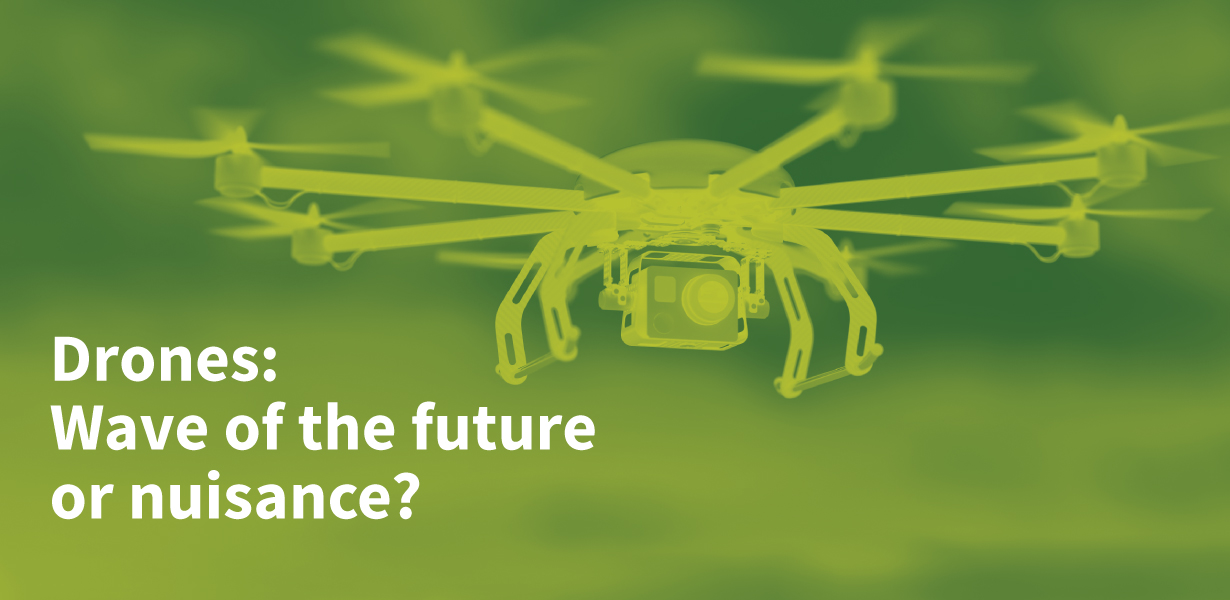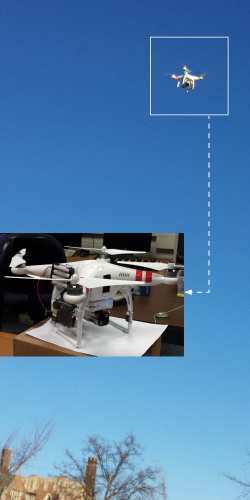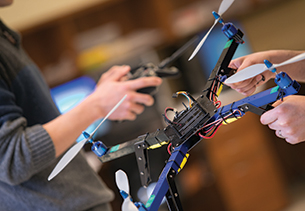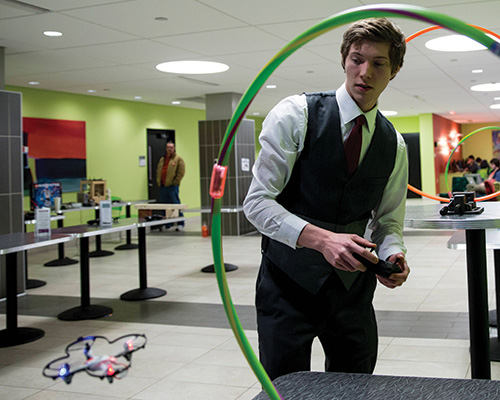Drones: Wave of the future or nuisance?

Faculty in the School of Engineering & Applied Science at Washington University in St. Louis are working to address these issues, since the low cost and accessibility of drones is leading them to become more common in some conventional and unconventional uses.
Drones: What are they?
Unmanned aerial vehicles or unmanned aerial systems, commonly known as drones or quad rotors, are smaller aircraft that can be used where it is too difficult, too risky or too expensive for a manned aircraft to fly. Ranging from $50 to millions of dollars, these aircraft run on short-lived batteries and generally cannot fly nearly as high as manned vehicles. They can be equipped with navigational equipment, such as a GPS, and sensors to read external conditions such as temperature, moisture and density, and often have cameras aboard to send back photos and videos to those controlling them.
The U.S. government already is using drones to manage federal lands, monitor wildfires, conduct scientific research, monitor borders, support law enforcement and to train the military. While there is a human operator controlling drones commercially available to the public, it’s not quite like operating a remote-control airplane. Drones are programmed with highly complex computer code to transmit data gathered by the sensors and cameras.
Taking the challenge

In his lab, Humberto Gonzalez, PhD, assistant professor in the Department of Electrical & Systems Engineering, is using drones as a platform to study controlling systems, such as smart homes or hydroelectric power plants. While it is difficult to test for problems in a hydroelectric power plant because of its scope and size, testing sensors, new code and algorithms in drones is easier and less expensive, and the outcome can be applied to larger systems, even to autonomous cars, Gonzalez says.
“In the particular case of autonomous vehicles like drones and cars, it’s very interesting for people like me because there is a place to do the things I like to do, which is work with theoretical problems, take them, write the code and make them work in real life,” he says.
Gonzalez and his team are working to make drones that fly indoors without bumping into walls, the ceiling or people. They buy drones from a toy store or online, flush out the code inside the drone and load in new code that they have written.
Why would someone want to fly drones indoors? Flying indoors presents more challenges than flying outdoors, Gonzalez says.
“If we’re going to make this completely autonomous, at the very least, we want it not to crash into the ceiling and walls,” he says. “We want to have a high degree of certainty that the code we wrote and the mathematical algorithms that we are using will not make it crash into the ceiling. We want to do most of the work before we even turn it on.”
Regulations and liability
In addition to flying drones indoors, Gonzalez is also interested in the liability and regulatory issues associated with drones.
“Liability is the biggest question out there,” he says. “The liability problem is completely open, and everyone is trying to say, ‘We can manage all of this, and we know what we’re doing.’”
For example: A real estate agent purchases a drone with a camera to take photographs of homes he or she is selling. The agent turns it on, it flies over the home and takes some photos. But something goes awry, and the drone falls and crashes through the windshield of a car in the neighbor’s driveway. Who is responsible for the damage: the agent, for making an error in operation while in control of the drone, or the drone manufacturer for a potential error in the code that may have caused it to crash?
Neil Richards, professor of law in the Washington University School of Law, says it’s important that engineers not allow concerns about liability to cloud the development of drone technology.
“We might want to have the questions of privacy cloud the development, or at least shape the development, of the deployment of the technology in ways that respect commitments to privacy, but mere legal uncertainty shouldn’t be something that stands in the way of developing these things,” says Richards, who also teaches in the Henry Edwin Sever Institute in the School of Engineering & Applied Science. “We’re living in a time when lots of new things are possible that weren’t possible before. The law is necessarily going to lag, because we don’t want to regulate everything prospectively, but wait until cases come up and we see problems before we deal with these things.”
Drone manufacturers could attempt to escape liability through writing a contract with its human supervisor.
“Companies can give you a contract that says, ‘You can fly this drone within certain conditions — no rain, no wind. If you meet all of those conditions, and the battery is charged, the drone will never crash,’” Gonzalez says.
While that may sound outlandish, that’s a similar contract that commercial airplane manufacturers have with airlines and that state motor vehicle departments have with drivers when they issue a driver’s license.

Gonzalez says there is no such contract — yet — for autonomous vehicles and drones, because the technology is still in its early stages.
“This is a highly mathematical problem that involves understanding what a quad rotor is capable of doing. We are studying the mathematical description of the dynamics of the quad rotor. Given the types of maneuvers the helicopter can do, which ones are safe and which are unsafe, given the data from the sensors?”
Security and safety
New proposed guidelines released by the Federal Aviation Administration Feb. 15 require unmanned aircraft to have an operator who has passed a test at an FAA-approved testing center and has obtained an unmanned aircraft operator certificate. In addition, operators would have to report any accident that results in injury or property damage to the FAA within 10 days, and drones must remain in the line of sight of the operator, which limits their use for delivery purposes.
One of the biggest concerns about the use of drones is their potential to interfere with commercial air traffic. Drone operators are required to notify an airport if they plan to fly within five miles of it. However, in late 2014, the FAA released that pilots and controllers had reported about 150 incidents of drones flying near aircraft or near misses to date that year.
Air traffic control towers are responsible to manage commercial air traffic in a certain area around each tower. If two planes are approaching each other, it’s the tower’s responsibility to prevent the crash. Will we need a control tower for drones?
“Probably not, because it defeats the purpose of speed,” Gonzalez says. “But if you have drones that are flying around, how do you control them? What if there is a drone traffic jam?”
Gonzalez says these are questions that will have to be answered as drones become used more frequently.
The U.S. military has been using drones for surveillance in foreign conflicts, and the U.S. Department of Homeland Security and U.S. Customs and Border Protection have been using drones to monitor activity on the nation’s borders. US CBP has the largest U.S. drone fleet of its kind outside of the military. But there has been considerable criticism of both programs from many groups, including the American Civil Liberties Union (ACLU), which argues that drones limit privacy and personal liberties.
Police departments, such as the St. Louis Metropolitan Police Department, have advocated for the use of drones to assist them in watching over large crowds or to help chase a suspect. While some police departments are using drones, the implementation nationwide has been slow due to privacy and safety concerns.
“Do we want to have particular rules for police drones, particularly weaponized drones with teargas or missiles or plastic flechette guns to control crowds, and do we want to have particular procedures in place before police will deploy a drone against civilians in the U.S.?” Richards asks. “These are things that we want to work out soon rather than after the fact. We’re going to need to strike some balances between police effectiveness and civil liberties and between the ability to use drones to look at the world and people’s rights of privacy against being spied on.”
Other applications

Raj Jain, PhD, professor of computer science & engineering, is working on other applications for drones in his lab. Jain’s group is working on a project called Cellular System for Emergency and Disaster Relief, based on the concept that natural disasters can compromise ground-based communication infrastructure, making it difficult for victims to contact safety personnel and for those personnel to communicate warnings. Under their proposal, unmanned aerial vehicles could be used to provide cellular access to users with standard mobile phones, improving communication during times of crisis.
“Ninety-six percent of the world has cell phones,” Jain says. “When there is any emergency, such as a hurricane or other natural disaster, cell towers are useless, and that is the time everyone wants to call someone.”
In addition, Jain says drones with sensors, which cost about $700, can be sent up for many other applications, including in forests to detect wildfires, temperature and carbon dioxide; in oil and gas exploration; wildlife and environmental monitoring; and in agriculture, in which sensors can be placed in crops to detect moisture levels or temperature.
Scaled-down drones
The WashU chapter of the American Society of Mechanical Engineers (ASME) has built a drone able to carry a camera and also works with palm-sized Hubsan X4 quadcopters, or microcopters, which are lightweight at only an ounce or two. The quadcopters, which operate by remote control similar to a model airplane, are a simple way to provide access to the technology, says Will Andersen, president of the ASME chapter and a senior majoring in mechanical engineering through the Dual Degree program.
While the quadcopters are inexpensive at about $40 each, they are unable to carry any weight other than the lithium battery used to power them, which lasts about 15 minutes before needing to be recharged.
Andersen says engineering students are very interested in working with the quadcopters and the drone, with about 40 students attending a recent event that allowed them to fly the quadcopters.
Ian Smith, a University College student majoring in global leadership & management and vice president of ASME, owns and built a mid-sized drone that can carry a Go-Pro camera. The team is able to make replacement parts for it using a 3-D printer.

In working with the quadcopters and drone, the team has two goals, Andersen says.
“We want to introduce people to the technology and become comfortable with it, and we want to learn how and why the quadcopters work and the scope of how they can be used,” he says.
Privacy
With drones now making films featured at public events such as the New York City Drone Film Festival, many have raised questions about privacy.
“Drones are their own thing, but by being digital network technologies, they raise all of the issues of computer security and digital privacy that Facebook or Google Glass or self-driving cars also raise,” Richards says. “We can’t let our fascination with the novelty and awesomeness of drones blind us to the fact that they raise really substantial issues, not just legal issues, but human issues about the way we use technologies, the way we design technologies, and the way these technologies fit into complex technological and human systems.”
The future
Recently, Amazon.com has proposed delivering packages via drone 30 minutes after ordering. Amazon Prime Air’s drones would have a 10-mile radius for delivery and would be able to carry about five pounds. However, the FAA’s Feb. 15 guidelines prevent any object from being dropped from an unmanned vehicle. In late March, the FAA gave Amazon permission to perform tests of its delivery drone in the U.S.; however, Amazon is no longer testing that model. The company has applied to test a newer model as well as for a commercial drone exemption.
Gonzalez says while Amazon’s proposed delivery by drone is technologically possible, there are still many unanswered questions and many different algorithms.
“Most of the algorithms are case by case,” he says. “As a larger question, can we write algorithms in a general way so that the Amazons of the world can be certain whether or not they need a control tower for their drones? And if they do, which is very likely in my opinion, what kind of control tower? All of these are potential questions that are out there waiting to be answered.”
Richards says although drones are new, they aren’t operating in a law-free environment, much like the early Internet in the mid-1990s, and that’s something engineers need to consider when designing them.
“We have FAA regulations that deal with flying things,” he says. “We have criminal laws that stop people from committing a crime, whether they use a drone, a gun or a video camera to blackmail or inflict emotional distress. Drones are going to create a lot of new possibilities for good and for bad and new ways of doing things, both good and bad, and the law will have to be adjusted to deal with the possibilities that drones present.”
Back to Engineering Momentum